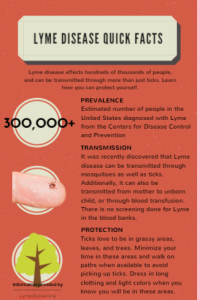Lyme Disease: Don’t Let it Tick You Off
How often do parents tell their children to check themselves for ticks after playing in the backyard? It is for good reason. The Lyme Disease that ticks carry along with them is not something to be taken lightly. Lyme is most common in North America, with Pennsylvania being the number one state in America as far as prevalence. Pennsylvanians, especially, should be aware of its dangers.
Lyme and its common coinfections, the various pathogen species that cohabitate with it, are widely misunderstood and even unknown by much of the public, and are sometimes mistaken for other diseases. Since it was identified in 1981, Lyme borreliosis, commonly referred to as Lyme Disease, has been a source of medical speculation and controversy.

Infographic by Emma Miller
Lyme Disease is typically difficult to diagnose and treat, largely because there is currently no reliable diagnostic test for it or its related coinfections. Instead, it is diagnosed through a combination of a patient’s symptoms, medical history, and tick exposure.
While several tests for it exist, they often yield inconsistent results. According to LymeDisease.org, 20-30% of people had false negatives in antibody tests. The Western Blot test, a more specific test than a basic screening test, will only give a positive result if five out of ten bands of Lyme are positive. However, testing positive for even one strand still indicates the presence of the disease. If available, having a doctor familiar with the disease look at a patient’s blood under a microscope is a good way to physically identify the Lyme and coinfections in the blood.
Symptoms are a more common way to diagnosis, and it is sound medical practice for a Lyme-literate doctor to treat a patient based off of symptoms. Initial symptoms of Lyme include a “bullseye” rash around a tick bite, fatigue, joint pain, and tingling sensations. If treatment for the disease is not begun in a timely manner, symptoms can become far more severe and even debilitating. If gone untreated, a build-up of problems can arise within the nervous system, circulatory system, digestive system, reproductive system, muscle and joint structures, and skin.
There is controversy within the medical practice about Lyme because ideals about proper diagnostics and treatment are varied. Some medical societies believe just a short course of antibiotics can eradicate the Lyme and believe it does not exist chronically. Others believe it takes rounds of long-term antibiotics along with holistic supplements and that it can become a chronic illness if not persistently treated.
Lyme can sometimes mimic other diseases, so it may be a good idea to look into being tested, especially in high risk areas such as Pennsylvania. Any present symptoms should be considered, and if you feel you should be treated, seek out a reputable, Lyme-literate doctor.
For more information, check out lymedisease.org or lymepa.org.
